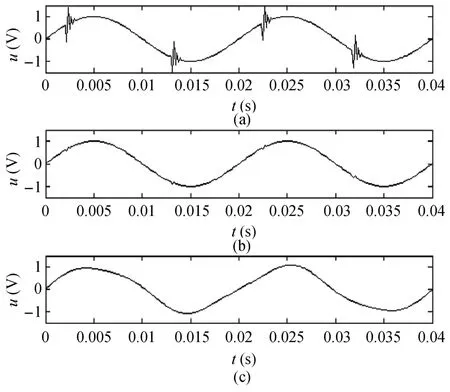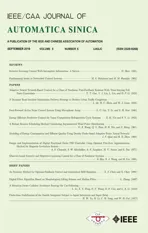Digital Filter Algorithm Based on Morphological Lifting Scheme and Median Filter
2018-09-28LanZhang
Lan Zhang
Abstract—When the circuits in which electronic products are fitted are disturbed by various interrupting signals,wave distortions occur to the normal voltage signals of these circuits.These wave distortions influence the normal operation and life cycle of electronic products.To eliminate the harmful effects of interrupting signals on electronic products,in this paper,a digital filter algorithm based on morphological lifting scheme and median filter(MLS-MF),which willbe used to filter various interrupting signals existing in the circuits in which electronic products are fitted,is proposed.A variety of interrupting signals have been included in simulation studies,and simulation results have demonstrated the effectiveness and feasibility of the proposed digital filter algorithm in high frequency continuous interference,random background noise and damped oscillatory transient interference filter.
I.INTRODUCTION
A NY one of electrical products composed of microelectronic devices can be considered as an electronic product.Electronic products which can be seen everywhere play an essentialrole in our daily life and production.However,interrupting signals arising in circuits where electronic products are fitted can cause wave distortions of signals of these circuits,which have an extremely negative impact on the normal operation and life cycle of electronic products.Therefore,to eliminate the harmful effects of interrupting signals on the normaloperation and life cycle ofelectronic products,efficient digital filter algorithm[1]are needed for the interrupting signals.
A number of digital filter algorithms have been used for the interrupting signals,such as short time Fourier transform(STFT)[2],fast Fourier transform(FFT),wavelet transform(WT)[3],mathematicalmorphology(MM)[4],etc.STFT and FFT have ideal filtering effects on interrupting signals except for signals interrupted by high frequency damped components.When processing signals interrupted by high frequency damped components,STFT and FFT need to linearize the attenuation factors of high frequency damped components in the interrupting signals,which seriously influences the filtering effects of STFT and FFT.WT needs not linearize the attenuation factors of high frequency damped components in the interrupting signals when it is used to filter the high frequency damped components in the interrupting signals[5].Therefore,WT has ideal filtering effects on all types of interrupting signals.Nonetheless,WT requires considerable amount of calculation[6],and its performance is severely affected by the selection of mother waveletfunction[7].MM,a nonlinear analysis method based on signalprocessing in time domain,is excellent in noise removing and calculation speed[8].Nonetheless,size and shape of structure element(SE)are often determined based on experience,which limits the applicability of MM[9].
To avoid the disadvantages of the above algorithms,in this paper,a novel digital filter algorithm based on morphological lifting scheme and median filter(MLS-MF)is proposed.The proposed algorithm employs morphological lifting scheme for its ability of information preserving and median filter for its advantage in noise removing.
II.METHODOLOGICAL BACKGROUND
A.Morphological Transform
MM was initially proposed to characterize physical or mechanical properties of certain materials,such as the permeability of porous media,by examining the geometrical structure of them.It was used as a quantitative description of shapes and sizes for binary images[10].
The original principle of MM stems from set theory.MM provides an algebraic formulation to apply neighbourhood operations on signals.The main notion of MM is the interaction between the signals underanalysis and an SE,where the signal and SE are considered as sets of points.The SE,as a probe,slides through the signal as a moving window,inspects its interaction with the signal,and detects specific features in the neighbourhood of every point in the signal[10].
1)Dilation and Erosion:Erosion and dilation are two basic operations of MM.Let f denote a signaland g denote an SE,and the length of g be considerably shorter than that of f.Dilation and erosion are defined as[11]

and

respectively,where⊕,⊖ denote the dilation and erosion operators,respectively.D(f),D(g)are the definition domains of f and g,respectively.
2)Opening and Closing:Opening is an operator that performs dilation on a signal eroded by the same SE.The definition is given as follows[12]:where◦denotes the opening operator.Opening can recover most structures lost by erosion,except for those completely erased by erosion.

Closing,on the other hand,can be defined by the duality of opening as[12]

where·denotes the closing operator.
B.The Lifting Scheme
A useful and very general technique for constructing new wavelet decompositions from existing ones has been recently proposed by Sweldens[13]and is known as the lifting scheme.A typicalcase of lifting scheme consists of three stages:split,predict,and update[6].
1)Split Stage:Let x represent a one-dimensional discrete signal.Then x can be split into two parts,the approximation signal part x1and the detail signal part y1[14].The most simple case is the one thatsplits x into even signalpart xe(n)=x(2n)and odd signal part xo(n)=x(2n+1).
2)Predict Stage:The detail signal y1is predicted using information contained in the approximation signal x1and is replaced by the prediction error

where P represents the prediction operator.The predictor erroris defined as the new detail signal.
Actually,the prediction procedure is equivalentto applying a high pass filter to the source signal x[12].
3)Update Stage:The approximation signal x1is updated using information contained in the new detail signal

where U represents the update operator.x′1is defined as the new approximation signal.
Like WT,the aforementioned three stages are carried out onrecursively[8].
If prediction and update operators are given by

respectively,then

The above lifting scheme is the so-called max-lifting scheme.In the above max-lifting scheme,as a prediction for y1(n)we choose the maximum of its two neighbors in x1,i.e.,x1(n)and x1(n+1).The update step is chosen in such a way thatlocalmaxima of the inputsignal x1are mapped to the new approximation signal[12].
If prediction and update operators are given by

respectively,then

The above lifting scheme is the so-called min-lifting scheme.
III.THE PROPOSED DIGITAL FILTER ALGORITHM
MLS-MF is developed as an extension of the morphological lifting scheme discussed in[13],which effectively combines the ability of MLS in information preserving and MF in noise removing.In the implementation process of MLS-MF,MLS and MF are applied to process interrupted signals sequentially.Let x0represent a one-dimensional discrete signal,the proposed digital fi lter algorithm consists of six steps:
Step 1:Decompose x0intond


where i=1,2,...,C,C= ⎿N0/6」.200 cases of signals are applied for training to select the optimal value of C.y= ⎿x」means y takes the largest integer value that satisfies the equation y≤x and N0is the number of samples of a fundamental cycle.

where j=1,2,...,B,B= ⎿N0/10」.F=0.08898.200 cases of signals are applied for training to select the optimal values of B and F,respectively.A is the amplitude of the fundamental frequency component of x0.
Step 3:Apply morphological min-lifting scheme to


Step 5:Update x0using y1

Step 6:Apply median filter to x′(n)

Therefore,for the given input signal x0,its MLS-MF is carried out according to the following recursive analysis scheme:

IV.SIMULATION STUDIES AND FIELD DATA EXPERIMENT
A.Simulation Studies and Discussion
Voltage signals from circuits where electronic products are fitted may be interrupted by various interrupting signals.In this paper,high frequency continuous interference,random background noise and damped oscillatory transientinterference are mainly considered.
1)High Frequency Continuous Interference: Fig.1(a)presents a typical voltage signal disturbed by high frequency continuous interference whose mathematical expression is

In order to evaluate the filtering performance of the proposed algorithm,an index of relative error of fundamental frequency signal(σ)is calculated to describe the similarity between the signal after filtering and the ideal sinusoidal signal.The performance of MLS-MF has also been compared with thatofmathematicalmorphology filter algorithm(MMF)proposed in[15].The definition ofσis

where

and x=1,2,...,256,257.
Fig.1(b)and Fig.1(c)give the filtering results of MLSMF and MMF,respectively.In Fig.1(b)and Fig.1(c),the σvalues of these two output signals are 0.0053 and 0.0224,respectively,which reveal that the filtering performance of the proposed scheme is more efficient than MMF.Massive tests have been conducted by varying the amplitude and components of high frequency continuous interference,and test results have demonstrated that MLS-MF can filter high frequency continuous interference effectively.
2)Random Background Noise:Fig.2(a)shows a typical voltage signal polluted by 10 dB white Gaussian noise(WGN).The output of MLS-MF and MMF are described in Fig.2(b)and Fig.2(c),respectively.As depicted in Fig.2(b)and Fig.2(c),MLS-MF can filter WGN contained in the voltage signal shown in Fig.2(a)effectively and efficiently,and the filter performance of MLS-MF is better than that of MMF.The performance of the proposed scheme is influenced by the signal-to-noise ratio(SNR)of WGN.When the SNR of WGN decreases,which means the ascentof the ratio of WGN in the interrupted signal,value ofσwill decrease.The impact of the SNR of WGN on the performance of the proposed scheme is shown in Table I.The results shown in the table come from the average of 30 testruns.The calculation values in Table I show strong evidence of the good performance of MLS-MF in random background noise.

Fig.1.(a)Voltage signal disturbed by high frequency continuous interference,(b)the processed resultwith MLS-MF,(c)the processed result with MMF.

Fig.2.(a)Voltage signal disturbed by random background noise,(b)the processed result with MLS-MF,(c)the processed result with MMF.
3)Damped Oscillatory Transient Interference:A sinusoidal voltage signal,whose amplitude is 1 V,disturbed by damped transient broadband interference,whose amplitude is 0.1 V,is shown in Fig.3(a).The filtering results of MLS-MF and MMF on the signal shown in Fig.3(a)are described in Fig.3(b)and Fig.3(c),respectively.In Fig.3(b)and Fig.3(c),the calculation values ofσare 0.0023 and 0.0088,respectively.The values ofσdemonstrate that MLS-MF has good performance in damped transient broadband interference filter,and this performance is better than that of MMF.A great number of tests have been undertaken by changing amplitude and interference’s frequency of damped transient broadband signal,and similar results have been obtained.

TABLE I THE IMPACT OF THE SNR ON THE PERFORMANCES OF MLS-MF,MMF,CT-FIR-S-GF AND IIRDF

Fig.3.(a)Voltage signal disturbed by damped oscillatory transient interference,(b)the processed resultwith MLS-MF,(c)the processed result with MMF.
To verify the superiority of MLS-MF,the performance of MLS-MF has also been compared with thatofcontinuous-time finite impulse response Savitzky-Golay filter(CT-FIR-S-GF)[16]and infinite-impulse-response digital filter(IIRDF)[17].Table Ialso presents a comparison of the index of relative error of fundamental frequency signal of each interrupting signal obtained by the three methods,respectively.For each type of interrupting signal,200 tests were carried out.As shown in Table I,MLS-MF is more effective than the restin interrupting signal components fi ltering.
B.Field Data Experiment
In this part,voltage signals with interrupting signal components from IEEE PES database[18]are adopted to test the effectiveness of the proposed digital filter algorithm[19].
Fig.4(a)shows a voltage signal with interrupting signal components from IEEE PES database.The filtering effects of the signal shown in Fig.4(a)by MLS-MF and MMF are depicted in Fig.4(b)and Fig.4(c),respectively.In Fig.4(b)and Fig.4(c),σequals 0.0015 and 0.0031,respectively.The values ofσare consistent with the filtering effects shown in Fig.4(b)and Fig.4(c),which together suggest the effectiveness and feasibility of MLS-MF in interrupting signals filter.

Fig.4.(a)Voltage signal with interrupting signal components from IEEE PES database,(b)the processed result with MLS-MF,(c)the processed result with MMF.
The above simulation results show that,in filtering various interrupting signals existing in the circuits in which electronic products are fitted,MLS-MF is more accurate than MMF,CT-FIR-S-GF and IIRDF,which effectively demonstrates the rationality of combination of MLS and MF.
Another advantage of MLS-MF is that in the process of noise filtering,the scheme only involves addition and subtraction,which reduces calculation burden greatly.In this paper,the computation time of MLS-MF is shorter than 0.005 s,which is very good for the negative influence of noise in the interrupted signals being obviated in time.
V.CONCLUSION
The MLS-MF,which effectively combines the ability of MLS in information preserving and that of MF in noise removing,has been proposed to filter various interrupting signals existing in the circuits in which electronic products are fitted.A interrupted signal is processed by morphological max-lifting and min-lifting schemes with SEs selected by numerous tests,and the output of morphological min-lifting scheme is processed by median filter.Compared with existing algorithms,the algorithm proposed in this paper is more capable of filtering interrupting signal components contained in the disturbed signals.The proposed algorithm has been evaluated on a batch of test signals interrupted by three types of interruptions under a variety of conditions,and voltage signals from IEEE PES database.Simulation results have shown that the proposed algorithm has good performance in various interrupting signals filtering.
杂志排行
IEEE/CAA Journal of Automatica Sinica的其它文章
- Iterative Learning Control With Incomplete Information:A Survey
- Fundamental Issues in Networked Control Systems
- Adaptive Neural Network-Based Control for a Class of Nonlinear Pure-Feedback Systems With Time-Varying Full State Constraints
- A Dynamic Road Incident Information Delivery Strategy to Reduce Urban Traffic Congestion
- Feed-Forward Active Noise Control System Using Microphone Array
- Energy Efficient Predictive Control for Vapor Compression Refrigeration Cycle Systems
